Intel's Pentium M on the Desktop - A Viable Alternative?
by Anand Lal Shimpi on February 7, 2005 4:00 PM EST- Posted in
- CPUs
Business/General Use Performance
Business Winstone 2004
Business Winstone 2004 tests the following applications in various usage scenarios:- Microsoft Access 2002
- Microsoft Excel 2002
- Microsoft FrontPage 2002
- Microsoft Outlook 2002
- Microsoft PowerPoint 2002
- Microsoft Project 2002
- Microsoft Word 2002
- Norton AntiVirus Professional Edition 2003
- WinZip 8.1

In business applications, the Pentium M does extremely well - with the 755 offering performance equivalent to that of an Athlon 64 FX-55. This is undoubtedly due to the extremely low latency L2 cache, which matters considerably in business applications.
Office Productivity SYSMark 2004
SYSMark's Office Productivity suite consists of three tests, the first of which is the Communication test. The Communication test consists of the following:"The user receives an email in Outlook 2002 that contains a collection of documents in a zip file. The user reviews his email and updates his calendar while VirusScan 7.0 scans the system. The corporate web site is viewed in Internet Explorer 6.0. Finally, Internet Explorer is used to look at samples of the web pages and documents created during the scenario."
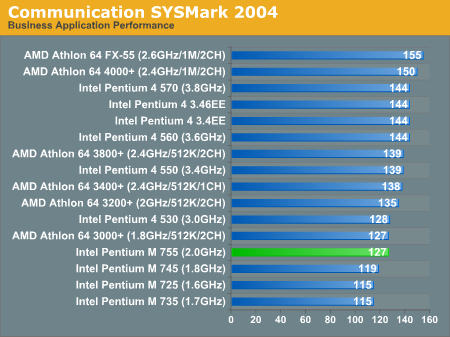
Immediately, we see that the Pentium M can't always do well, as even the 2.0GHz Pentium M 755 can't outperform the Athlon 64 3000+. The communication suite stresses memory bandwidth and latency rather than applications and usage patterns that fit into cache, so the Pentium M loses out big time.
The next test is Document Creation performance, which shows very little difference in drive performance between the contenders:
"The user edits the document using Word 2002. He transcribes an audio file into a document using Dragon NaturallySpeaking 6. Once the document has all the necessary pieces in place, the user changes it into a portable format for easy and secure distribution using Acrobat 5.0.5. The user creates a marketing presentation in PowerPoint 2002 and adds elements to a slide show template."
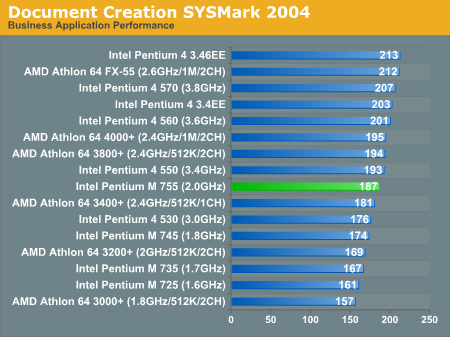
The Pentium M does a bit better in the document creation tests, as they are mostly using applications that will fit within the CPU's cache. However, the introduction of a voice recognition program into the test stresses the Pentium M's floating point performance, which does hamper its abilities here.
The final test in our Office Productivity suite is Data Analysis, which BAPCo describes as:
"The user opens a database using Access 2002 and runs some queries. A collection of documents are archived using WinZip 8.1. The queries' results are imported into a spreadsheet using Excel 2002 and are used to generate graphical charts."
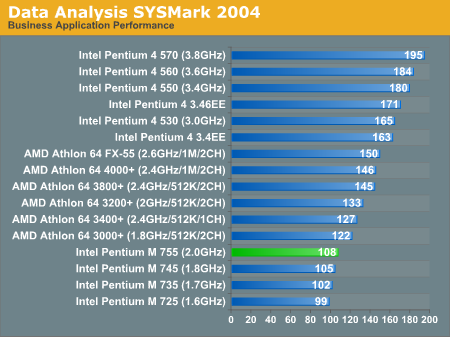
Without a doubt, the inclusion of Access usage patterns in the data analysis suite kills the Pentium M's chances here, as it once again brings up the tail in performance.
Microsoft Office XP SP-2
Here, we see in that the purest of office application tests, performance doesn't vary all too much.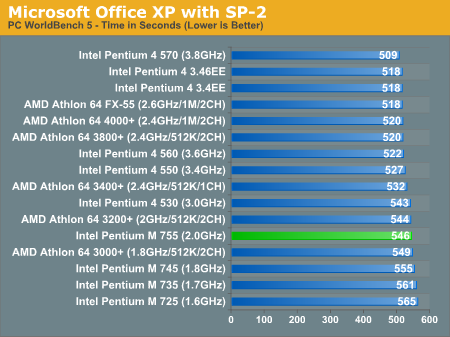
The Pentium M is competitive here, but so are all of the other CPUs.
Mozilla 1.4
Quite possibly the most frequently used application on any desktop is the one that we pay the least amount of attention when it comes to performance. While a bit older than the core that is now used in Firefox, performance in Mozilla is worth looking at as many users are switching from IE to a much more capable browser on the PC - Firefox.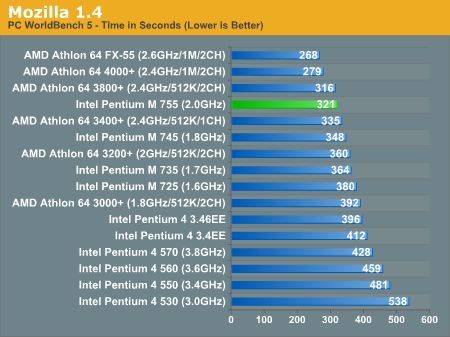
The Pentium M does extremely well here, outperforming both Athlon 64 and Pentium 4 competitors. Only the higher clock speed of the Athlon 64 gives it the overall lead here.
ACD Systems ACDSee PowerPack 5.0
ACDSee is a popular image editing tool that is great for basic image editing options such as batch resizing, rotating, cropping and other such features that are too elementary to justify purchasing something as powerful as Photoshop. There are no extremely complex filters here, just pure batch image processing.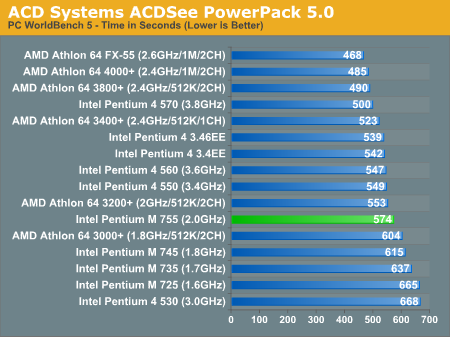
Once again, we see the Pentium M bring up the rear in situations where its low latency L2 cache can't help it.
Winzip
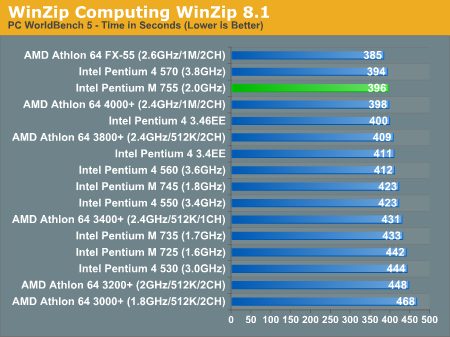
The Pentium M is fairly competitive in the real-world WinZip test - coming in third place overall, but the margin of victory isn't too great.
Let's look at how its peak theoretical performance is under WinRAR's built in benchmark:
WinRAR 3.40
Pulling the hard disk out of the equation, we can get a much better idea of which processors are truly best suited for file compression.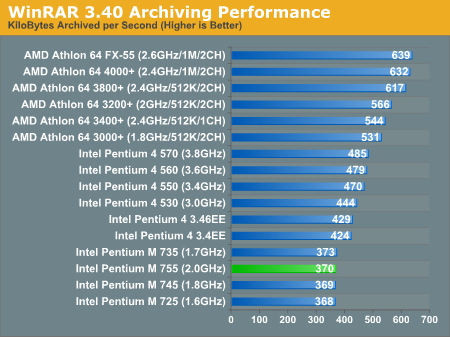
Here, we see that the lack of memory bandwidth really hurts the performance potential of the Pentium M. Luckily, most archiving tasks are usually disk-limited, so the performance differential won't be this bad in reality.










77 Comments
View All Comments
Lupine - Wednesday, February 16, 2005 - link
I'm surprised at these results. I'm setting up a new Dell Inspiron 9200 (M 725 @ 1.6GHz/400MHz FSB) and it is schooling both my Barton 2500+ @ 2.2GHz and TBred B 1700+ @ 2.2GHz running Stanford's Folding@Home project (600 point proteins: ~37min per frame for the XP boxes compared to ~34min per frame w/ the laptop).So, if it is so weak, what is allowing it to process WUs at such a competitive rate? Sure, that is slower than an A64, but competitive w/ most P4 procs.
fitten - Thursday, February 10, 2005 - link
Something else to remember about the Banias/Dothan line of chips... Agressive power reduction was the #1 goal of the design process. In a 'normal' chip design, not all pipeline stages are the same length, the clock speed it runs at is the speed of the slowest part of the CPU. Since power usage is directly related to the frequency of the switching gates, the Intel engineers actually deliberately slowed down some parts of the chip to match the target release speeds (or get close to them) to reduce power consumption. This is, perhaps, the main reason why the frequencies don't scale so well as some would want them to scale.Visual - Thursday, February 10, 2005 - link
here's another thought... when the opterons launched initially at ECC DDR266, there were similar comments like "give it unbuffered DDR400 or higher and stay out of its way" :) well, now that we have that, ok it did improve performance a bit. but not hugely. shouldn't help the dothan significantly more too.Visual - Thursday, February 10, 2005 - link
I like how AMD got beaten by the P-M :) not because im intel fan, just because this will make things more interesting now.don't catch flame from this comment :p its my oppinion
Funny how you picked the game benchmarks btw, its almost as if you wanted to show the P-M lacking behind the A64... from what I've seen it beats A64 in HL2 and CSS, and that's a game you don't skip usually :) so why now?
Also looks suspicious how in lots of tests where P-M performs well with the A64 clock-for-clock or beats it, there is almost no difference in the 3800+ and 4000+ results... like if L2 isnt all that important, yet L2 is exactly how everyone explains the P-M success
Maybe we'll see some 2MB L2 A64 "emergency edition" once Dothan gets a decent desktop chipset, just like what intel did to (try to) save P4 from the A64 :)
actually i'd be happy if Dothan motivates AMD to develop faster L2 cache or something.
Knowing Intel, i dont expect they'd even try to match AMD's prices with the P-M... and there's a lot of room for AMD to decreace prices, as they're selling with quite a margin now. So for sure the P-M won't be cost-effective compared to A64, not if you don't care for ultra-low power consumption at least.
also it doesn't look likely Dothan could scale beyond 2.6GHz on current 90nm tech. by the time it gets there, AMD should've launched the 2.8 FX and most likely 3GHz too. so I have no doubts AMD will keep the lead for quite a while... maybe the race to 65nm will be the next turning point, as it seems its going smooth for intel (at least for P-M)
anyway, even if AMD is better in absolute performance, pricepoint and (arguably) clock-for-clock, you gotta admit it to the P-M, it does quite a punch. fun times are coming :)
Zebo - Wednesday, February 9, 2005 - link
dobwal buy intel if you want mhz, AMD is for performance.dobwal - Wednesday, February 9, 2005 - link
i wasn't referring to the FX series. Plus you are not understanding the point i was trying to make. Lets take a look at the FX series.OPN Model Operating Freq. Package ADAFX55DEI5AS FX55 2600MHz 939-Pin
ADAFX53DEP5AS FX53 2400MHz 939-Pin
ADAFX53CEP5AT FX53 2400MHz 940-Pin
ADAFX51CEP5AT FX51 2200MHz 940-Pin
ADAFX51CEP5AK FX51 2200MHz 940-Pin
the first FX51 was release around late third quarter 2003. So in a little over a year the FX series has only increased 400 Mhz. Can you automatically assume that the FX has poor scalability in terms of cpu speed. NO. You know why, because the EE is underperforming and can't touch the FX. AMD has no need to push large scale speed increases out of the FX line, which would do nothing but increase cost with each new stepping it used to boost performance.
The same goes for the Dothan at 2.26Ghz by the end of 2005. What other cpu offers the same level of performance vs. battery life. So why push for performance except to push sales.
You simply can't determine the scalabiltiy of a cpu based on its roadmap especially when its the performance leader in its market segment and has no current viable competitor or one in the near future.
Aileur - Wednesday, February 9, 2005 - link
Oh and, superpi relies on the fpu to do its calculations, so so much for this fpu is crap trend we have going here.http://mod.vr-zone.com.sg/Aopen_i855_review/25sPIm...
Aileur - Wednesday, February 9, 2005 - link
Oh and before you start bragging about the better superpi1mb result of the a64http://www.akiba-pc.com/DFI_855/d17g_2608_spi1m.gi...
this is 1 sec better, with 100mhz less, and single channel ram.
Aileur - Wednesday, February 9, 2005 - link
Since you seem to like xtremesystemshttp://www.akiba-pc.com/DFI_855/d15g_2435_spi1m.PN...
also a 1ghz overclock, also on default voltage
Id like to see how an a64 would perform on a kt266 (if that were possible)
Give the pentium m time to mature and all those "OMG HAHA YOU CPUZ IS SO HOT LOLOL!!!1111" will be obsoleet.
Zebo - Wednesday, February 9, 2005 - link
58 "How long has A64 been stuck on 2.4Ghz."----------------------------------
There not. 2.6 FX-55 been out for months. More importantly AMD does'nt have to release new chips the way they dominate the benchmarks now. Could they? Hell ya.They got a nice buffer going, New FX's hit 3.0 on stock air. Cheap 90nm's are now hitting 2.7 on default Vcore and air. And by air I mean AMD's cheap all aluminum HS with a itty bitty 15mmx70mm fan, not Prescotts copper core screamers.
T8000- You're clueless. Maybe it's the heat generated by your prescott making your head woozy, I dunno, but have a look here..1800 Mhz to 2800 Mhz on default Vcore stock fan.
http://www.xtremesystems.org/forums/showthread.php...